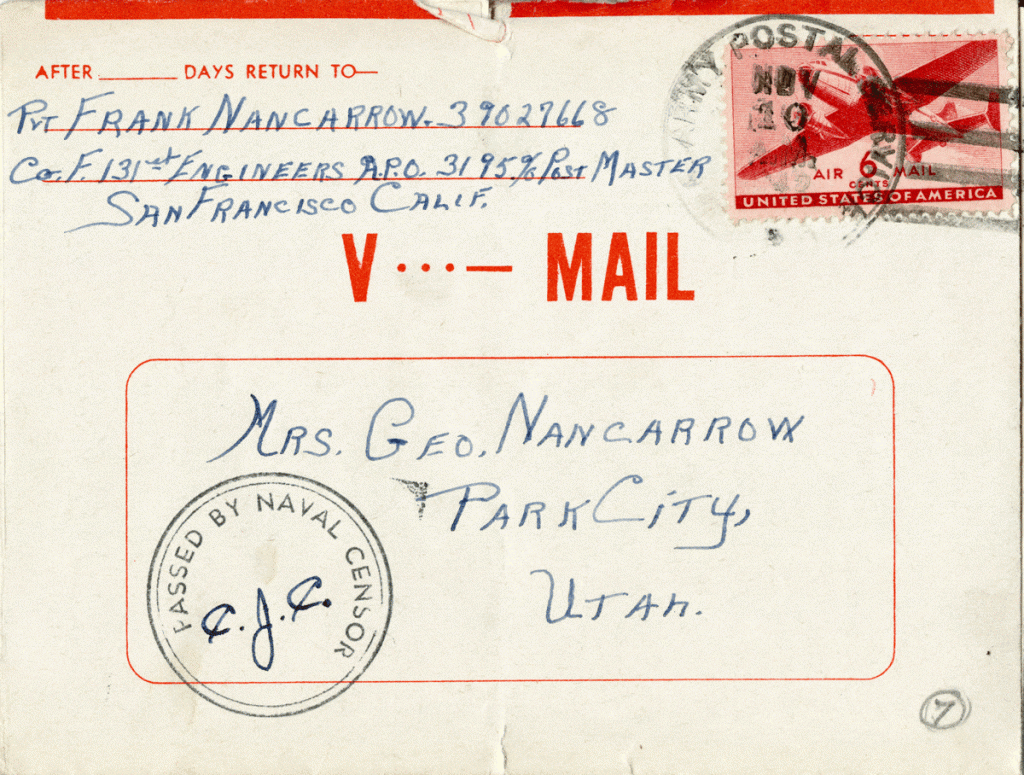During World War II, Parkites kept informed of war events primarily via newpapers, radio broadcasts and newsreels played in movie theaters. However, the news families treasured most came directly from the letters of their soldiers in the field.
Wartime correspondences were relayed in part via a postal system known as “Victory mail’ or V-mail. This system was implemented to condense the space required to deliver the mail. Letters were penned on special forms and converted to microfilm for transport. Letters were then reproduced on arrival in the U.S. Although only in use from June 1942 until November 1945, more than 1 billion pieces of mail were processed through the V-mail system.

Credit: Park City Historical Society & Museum, Mary Martin Vincent Collection
Letter writing during the war was prolific and provided the means for the most personal and direct touchstone to events happening both on the battlefield and the home front. The 1942 Annual Report of the Postmaster General encouraged letter writing by proclaiming that “communication with parents, associates and other loved ones strengthens fortitude, enlivens patriotism, makes loneliness endurable and inspires to even greater devotion the men and women who are carrying on our fight far from home and from friends.” Letters arriving from soldiers contained personal accounts of daily lives and perspectives on the war.
Likely in the spring of 1945, Park City soldier John A. Dreitzler wrote to his grandparents from an undisclosed location in Germany asking them for a letter from home. In Dreitzler’s letter he stated: “I have seen all the combat I want to, but we all will probably see a lot more before we reach Berlin. From what we hear over here the people in America are celebrating the end of the war already. They are very much wrong if they think the war is over…” Of course, V-E Day followed soon thereafter, and the war was over before the end of the year. Dreitzer made his way home to Utah, where he took a position at the Army Depot in Toole, met his future wife, and remained married to her for 69 years until his passing in 2016.

Credit: Park City Historical Society & Museum, Mary Martin Vincent Collection
It wasn’t just letters and care packages soldiers treasured; they eagerly anticipated receiving copies of their hometown newspapers. The editor of the Park Record during this time, Sam “Dad” Raddon, stated that “the part of his paper which directly appeals to most readers is that section he reserves for news from servicemen and women.” His statement referred to a regular column entitled “With Our Boys in the Armed Forces” which contained correspondences submitted by soldiers and updates furnished by their families.
Letters from local soldiers who received the Park Record underscored how the paper helped them feel connected to their community. Two such letters were included in December 1942. Air Corps Private William. R. Price wrote: “Received my first copy of The Record today. It is like a lot of letters from home put up in one bundle. There is nothing that we in the armed forces like better than those letters from home.” Army Private Harvey D. Booth offered: “It really helps to hear from the old home town via the home town paper. It really helps those boys in camps all over the world to read of the doings in the places they have lived and of the people they hold close to their hearts.”
The troves of wartime letters archived in museums provide a deeply personal, firsthand look into the American experience of war and its effects on the soldiers who fought bravely, their loved ones and the communities they called home.
To view war correspondence in the Park City Museum’s collections, set up an appointment to visit the Hal Compton Research Library. The Museum is also hosting a virtual lecture on war letters, given by author Sydney Williams on Wednesday, February 24 from 5 p.m. to 6 p.m. Register here.